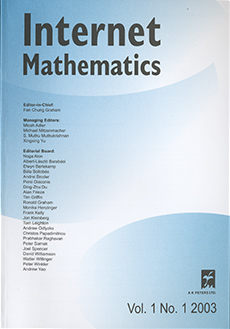Abstract
Random graph theory is used to examine the "small-world phenomenon"---any two strangers are connected through a short chain of mutual acquaintances. We will show that for certain families of random graphs with given expected degrees, the average distance is almost surely of order $\log n / \log \tilde d$ where $\tilde d$ is the weighted average of the sum of squares of the expected degrees. Of particular interest are power law random graphs in which the number of vertices of degree k is proportional to $1/k^{\beta}$ for some fixed exponent $\beta $. For the case of $\beta > 3$, we prove that the average distance of the power law graphs is almost surely of order $\log n / \log \tilde d$. However, many Internet, social, and citation networks are power law graphs with exponents in the range $2 < \beta < 3$ for which the power law random graphs have average distance almost surely of order $\log \log n$, but have diameter of order $\log n$ (provided having some mild constraints for the average distance and maximum degree). In particular, these graphs contain a dense subgraph, that we call the core, having $n^{c/\log \log n} $ vertices. Almost all vertices are within distance $\log \log n$ of the core although there are vertices at distance $\log n$ from the core.
Citation
Fan Chung. Linyuan Lu. "The Average Distance in a Random Graph with Given Expected Degrees." Internet Math. 1 (1) 91 - 113, 2003.
Information




